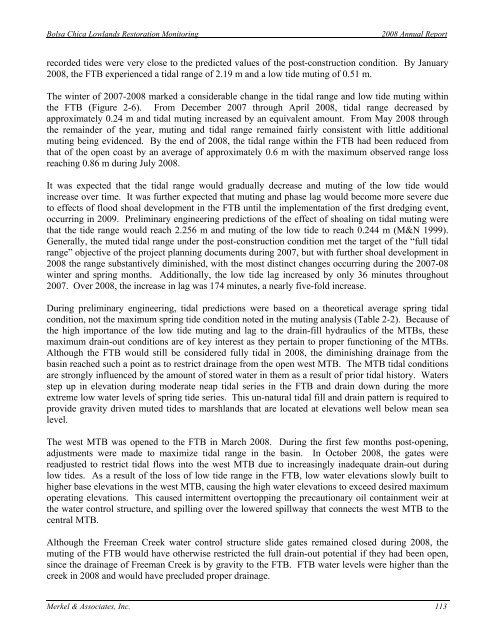2008 Annual Monitoring Report (pdf 10.9MB) - Bolsa Chica ...
2008 Annual Monitoring Report (pdf 10.9MB) - Bolsa Chica ...
2008 Annual Monitoring Report (pdf 10.9MB) - Bolsa Chica ...
You also want an ePaper? Increase the reach of your titles
YUMPU automatically turns print PDFs into web optimized ePapers that Google loves.
<strong>Bolsa</strong> <strong>Chica</strong> Lowlands Restoration <strong>Monitoring</strong><br />
<strong>2008</strong> <strong>Annual</strong> <strong>Report</strong><br />
recorded tides were very close to the predicted values of the post-construction condition. By January<br />
<strong>2008</strong>, the FTB experienced a tidal range of 2.19 m and a low tide muting of 0.51 m.<br />
The winter of 2007-<strong>2008</strong> marked a considerable change in the tidal range and low tide muting within<br />
the FTB (Figure 2-6). From December 2007 through April <strong>2008</strong>, tidal range decreased by<br />
approximately 0.24 m and tidal muting increased by an equivalent amount. From May <strong>2008</strong> through<br />
the remainder of the year, muting and tidal range remained fairly consistent with little additional<br />
muting being evidenced. By the end of <strong>2008</strong>, the tidal range within the FTB had been reduced from<br />
that of the open coast by an average of approximately 0.6 m with the maximum observed range loss<br />
reaching 0.86 m during July <strong>2008</strong>.<br />
It was expected that the tidal range would gradually decrease and muting of the low tide would<br />
increase over time. It was further expected that muting and phase lag would become more severe due<br />
to effects of flood shoal development in the FTB until the implementation of the first dredging event,<br />
occurring in 2009. Preliminary engineering predictions of the effect of shoaling on tidal muting were<br />
that the tide range would reach 2.256 m and muting of the low tide to reach 0.244 m (M&N 1999).<br />
Generally, the muted tidal range under the post-construction condition met the target of the “full tidal<br />
range” objective of the project planning documents during 2007, but with further shoal development in<br />
<strong>2008</strong> the range substantively diminished, with the most distinct changes occurring during the 2007-08<br />
winter and spring months. Additionally, the low tide lag increased by only 36 minutes throughout<br />
2007. Over <strong>2008</strong>, the increase in lag was 174 minutes, a nearly five-fold increase.<br />
During preliminary engineering, tidal predictions were based on a theoretical average spring tidal<br />
condition, not the maximum spring tide condition noted in the muting analysis (Table 2-2). Because of<br />
the high importance of the low tide muting and lag to the drain-fill hydraulics of the MTBs, these<br />
maximum drain-out conditions are of key interest as they pertain to proper functioning of the MTBs.<br />
Although the FTB would still be considered fully tidal in <strong>2008</strong>, the diminishing drainage from the<br />
basin reached such a point as to restrict drainage from the open west MTB. The MTB tidal conditions<br />
are strongly influenced by the amount of stored water in them as a result of prior tidal history. Waters<br />
step up in elevation during moderate neap tidal series in the FTB and drain down during the more<br />
extreme low water levels of spring tide series. This un-natural tidal fill and drain pattern is required to<br />
provide gravity driven muted tides to marshlands that are located at elevations well below mean sea<br />
level.<br />
The west MTB was opened to the FTB in March <strong>2008</strong>. During the first few months post-opening,<br />
adjustments were made to maximize tidal range in the basin. In October <strong>2008</strong>, the gates were<br />
readjusted to restrict tidal flows into the west MTB due to increasingly inadequate drain-out during<br />
low tides. As a result of the loss of low tide range in the FTB, low water elevations slowly built to<br />
higher base elevations in the west MTB, causing the high water elevations to exceed desired maximum<br />
operating elevations. This caused intermittent overtopping the precautionary oil containment weir at<br />
the water control structure, and spilling over the lowered spillway that connects the west MTB to the<br />
central MTB.<br />
Although the Freeman Creek water control structure slide gates remained closed during <strong>2008</strong>, the<br />
muting of the FTB would have otherwise restricted the full drain-out potential if they had been open,<br />
since the drainage of Freeman Creek is by gravity to the FTB. FTB water levels were higher than the<br />
creek in <strong>2008</strong> and would have precluded proper drainage.<br />
Merkel & Associates, Inc. 113






